This is Hainanese Chicken rice recipe, the way I’ve always made it plus an easier version for the many readers who’ve asked for it over the years.
Estimated reading time: 16 minutes
Table of contents
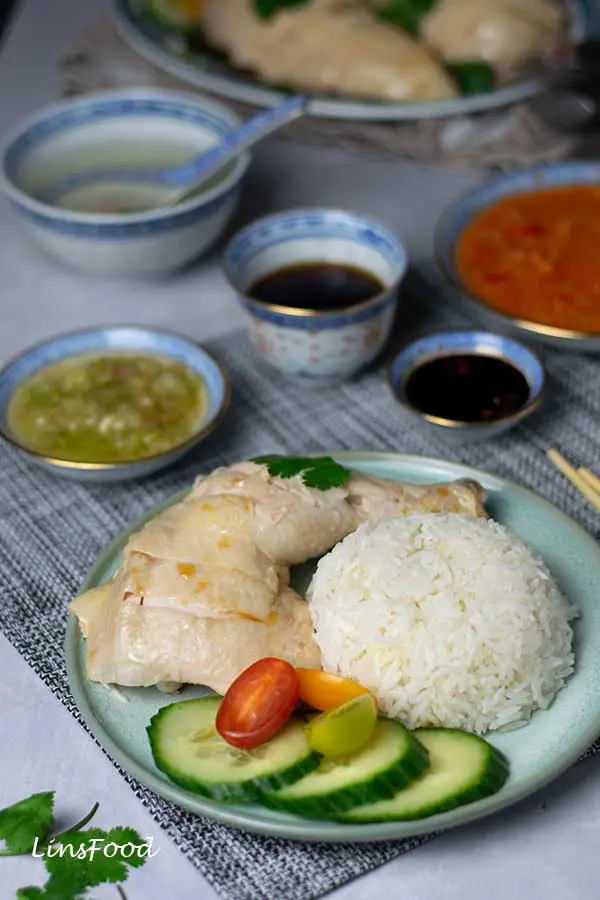
What is Hainanese Chicken Rice?
Hainanese Chicken rice is a chicken and rice dish of lightly poached chicken, served alongside rice that’s been cooked in the poaching liquid, with ginger-garlic chilli sauce and soup made from the poaching liquid.
I’ll talk you through all of this.
It is one of our most beloved local dishes, alongside the chilli crab, laksa and beef rendang. Hit any hawker centre or food court in Singapore and Malaysia, and you are going to find chicken rice, whether that’s today’s Hainanese chicken rice or the Malay Nasi Ayam with fried or grilled chicken.
- Nasi = rice
- ayam = chicken
Where is Hainanese Chicken Rice from?
So Hainanese is an adjective to describe anything related to Hainan, an island province of China that sits next to Vietnam in the South China Sea.
Hainanese Chicken rice is attributed to this island, and specifically, to the city of Wengchang.
Wengchang chicken is a breed of chicken as well as a dish of lightly poached chicken served with a dip made of chillies, garlic, soy sauce and calamansi lime juice, at its most basic.
As mentioned on this brief history page, many Chinese immigrated to Malaya and the surrounding area in the early 19th century.
The folks from Hainan brought along their precious Wengchang recipe. It didn’t take long for the recipe to transition into the local versions as we know them today, complete with rice and condiments. You have:
- Hainanese Chicken Rice in Singapore, Malaysia and Indonesia
- Com Ga in Vietnam
- Khao Man Gai in Thailand
The Recipe
Is it easy to cook Hainanese chicken rice at home? I’m not going to lie, there are a few parts and steps to the recipe. It’s definitely one to cook on a quiet Saturday or Sunday.
But so many of you have asked me for this recipe over the years. Like me, I know you’ll want to spend that time making this most beloved of recipes, since we don’t have the luxury of hawker centres where we are.
Let’s take a look at what makes a complete Hainanese Chicken Rice, shall we? We’ll look at the must-haves and the optional.
Then I’ll break the steps down and we can look at how to make it slightly easier, as mentioned in the title of this article. * denotes a must-have component.
- Chicken *
- Rice *
- Ginger-garlic chilli sauce * – this is THE chicken rice dipping sauce
- Soup (from the poaching liquid) *
- Sambal Kicap – optional but so good
- Ginger and spring onion (scallion) oil – optional but boy, does it hit the spot! This oil makes a frequent appearance in our house, as it’s a great way to liven up a noodle dish.
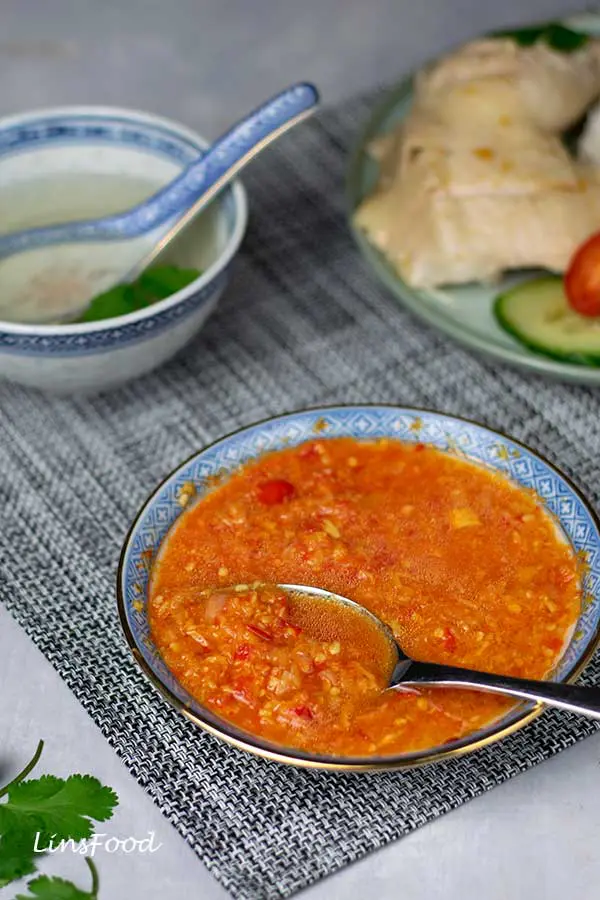
Traditional Hawker Fare
Hainanese chicken rice is zichar food at its best (Zichar = Chinese food stall). Every stall is going have its own little variation, perhaps in the condiments served or in the addition of a spice/aromatic or two.
But the principle behind the dish remains the same. This is what we’ll be doing to cook Hainanese chicken rice at home:
- If your chicken is not smooth and has the odd tiny feather left, rub it with salt to smooth out the skin. This is optional, and I usually don’t bother as I’m happy with the quality of the chicken I get. Rinse.
- Remove the fatty deposits from the chicken (whether whole or portions).
- Poach the chicken.
- Render the chicken fat from step 2. We did this with duck fat in KL Hokkien Mee.
- Hang the chicken up to dry after rubbing sesame oil all over (I give you an alternative).
- Cook the rice with the poaching liquid and aromatics (I’ll give you stove top and rice cooker).
- Keep the poaching liquid simmering on low heat.
- Make the ginger-garlic chilli sauce (this uses a little poaching liquid).
- Make the ginger-spring onion oil (scallion) (optional).
- Make the sambal kicap (spicy soy sauce – optional).
- Strain the poaching liquid, then adjust seasoning to create a light, clear soup to go with our meal.
- Chop up the chicken and serve with the rice, the condiments and the soup for everyone.

Easy Hainanese Chicken Rice
Or easier, to be precise. Because let’s face it. You want the real thing, you have to put in a little effort.
If you’ve been a long time follower of LinsFood, whether here or on LinsFood.com, you’ll know that I don’t really do quick and easy stuff. While I have done the odd one, my blogs are mainly about traditional food done the traditional way. Sometimes, made slightly easier.
So to make this chicken rice easier to cook:
- Use chicken portions instead of a whole chicken and follow the quicker and easier recipe below.
- Cooking the rice in a rice cooker is easier but the stove top is no rocket science. Follow my recipe as it is and advice on how to cook white rice (below), and you’ll be golden.
- Only make the ginger-garlic chilli sauce. Really, at most hawker centres, that’s all you get anyway, along with a sad looking and tasting soup.
- Then of course, strain the stock and flavour and serve as the soup.
Ingredients/The Recipe
Chicken
In hawker centres, a whole chicken is cooked and chopped up to be served in portions as ordered. I’m giving you this option, as well as cooking chicken portions for the whole recipe.
Using chicken portions is more convenient for the home cook and you don’t lose out in any way on flavour and the eating. I’ve been cooking Hainanese chicken rice for almost as long as I’ve lived in the UK, so trust me on this. That’s just shy of 30 years, if you’re wondering.
Another advantage in using chicken pieces when cooking Hainanese chicken rice at home is that you need less water, giving you a more potent poaching liquid. That means more flavour all around.
However, you absolutely must have on the bone portions and skin-on chicken. Otherwise, your stock is going to be rather insipid. And chicken rice without chicken skin is just not the same thing.
My favourite chicken portions for this are chicken legs, but you can also use chicken breasts or chicken thighs, both on the bone.
In the whole chicken recipe below, I also list either 6 chicken wings or 2 handfuls of chicken bones. This is to add more flavour and depth to our chicken stock. Because if your chicken stock is weak, your rice will be bland.
The chicken is lightly poached with skin bordering on pink. Its skin is gelatinous and is very similar to our saliva chicken, a Chinese recipe from mainland China. Recipe is here on LinsFood.
Bring your chicken out of the fridge at least an hour before cooking, to allow it to come to room temperature.
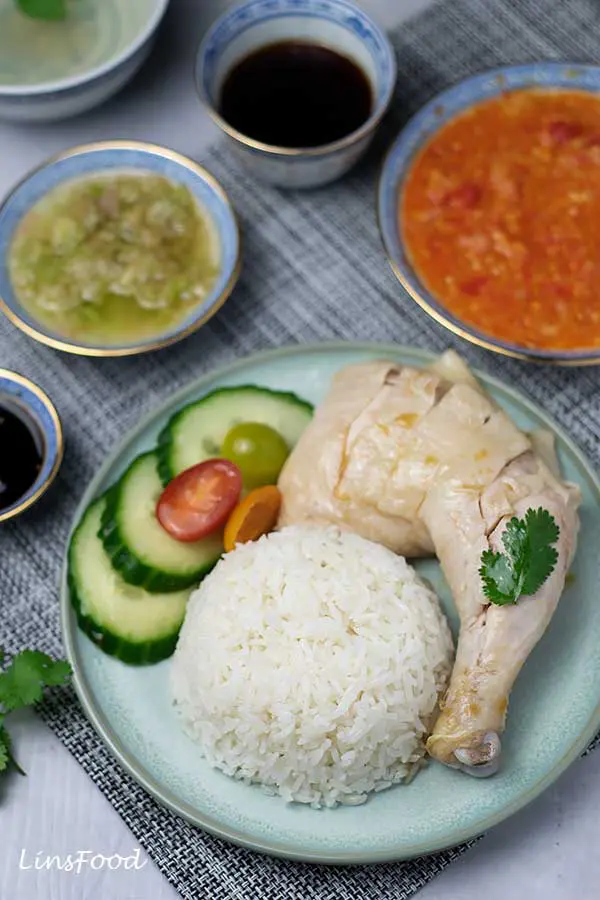
Water and Ice Cubes
When the chicken is done poaching, we give it an ice bath for 10 minutes. This stops the cooking process, and produces that gelatinous skin texture synonymous with Hainanese chicken rice.
You need ice cubes to maintain the cold temperature of the water.
Poaching Liquid in Hainanese Chicken Rice
The poaching liquid in chicken rice plays a very, very important role. It’s what we use to cook the rice and also flavours our chilli sauce.
The end result is a clear chicken broth or soup that’s to be consumed alongside the rice.
How much water we use to poach the chicken influences the final strength of our poaching liquid, and therefore, also the flavour of the rice. Cooking a whole chicken is going to require much more water then cooking portions, and will, inevitably, result in a weaker stock.
Traditionally, the liquid would be flavoured with msg, which goes a long way in compensating for the huge amount of water used. But I don’t do msg. What I teach and do in my classes, and this recipe, is to simmer the poaching liquid after cooking the rice, to reduce it. Plus the extra wings and bones as mentioned already. This will increase the strength of our soup served with the rice.

Rice for Hainanese Chicken Rice
Another piece of the puzzle, the rice, is also crucial to the equation. What rice to use? Jasmine rice is best, in my opinion. Its perfumed nature is a great complement to the subtleties of Hainanese chicken rice.
You can also use basmati rice or any other good quality long grain rice.
We cook the rice in the chicken stock as well as a neutral oil that’s been flavoured with aromatics (onion/shallot, garlic, ginger)
A question I get asked a lot in my Hainanese chicken rice cooking classes is the use of a pressure cooker or instant pot.
Bottom line: there really isn’t any need for it. Rice only takes 20 minutes or so to cook and the chicken wants to be poached GENTLY and LIGHTLY. Using an instant pot or pressure cooker isn’t going to give you the right texture and delicately cooked chicken.
Aromatics and Herbs
We use ginger, garlic, chillies and spring onions (or shallots). They are all equally important in the part they play, and together contribute to the individual parts of the recipe, and also the final combination.
TIP: Ginger comes in various sizes. You want fairly thick ginger. If yours is fairly thin, increase the amount by about 2.5cm – 5cm (1″-2″). In each part of the recipe.
Pandan leaves are a common addition when cooking the rice itself, but they’re optional. They add a lovely aroma to the jasmine rice.
If truth be told, most Chinese hawkers don’t use pandan leaves when cooking their chicken rice. This is something the Malays tend to do when cooking nasi ayam (nasi = rice, ayam = chicken). The Malay chicken rice is a little different from the Hainanese version, but I love it just as much. A recipe for another day!
Do you use lemongrass for Hainanese chicken rice? Not really. But if you fancy it, just a bruised stalk will suffice in the rice.
But just remember that the beauty of this dish is how all the subtle flavours come together to produce something rather exceptional. So less is more.
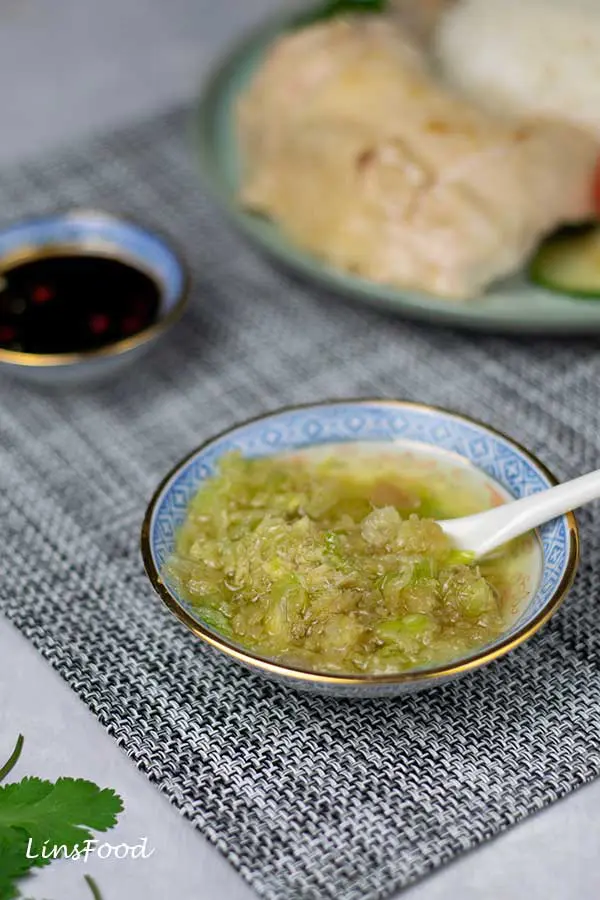
Oil
We need sesame oil as well as some sort of neutral oil. The latter can be any vegetable or corn oil or even peanut oil.
Your sesame oil wants to be toasted, which is the most common type sold in shops and supermarkets.
Soy Sauce
Light soy sauce, the generic soy sauce mentioned in many Chinese recipes, is what we’ll be using here in our dressing.
I give you an optional condiment in the form of our sambal kicap, which is just dark soy sauce spiced up with chillies and stuff. 5-minute job, and is rather delicious with Hainanese chicken rice. Click here for the link to that recipe.
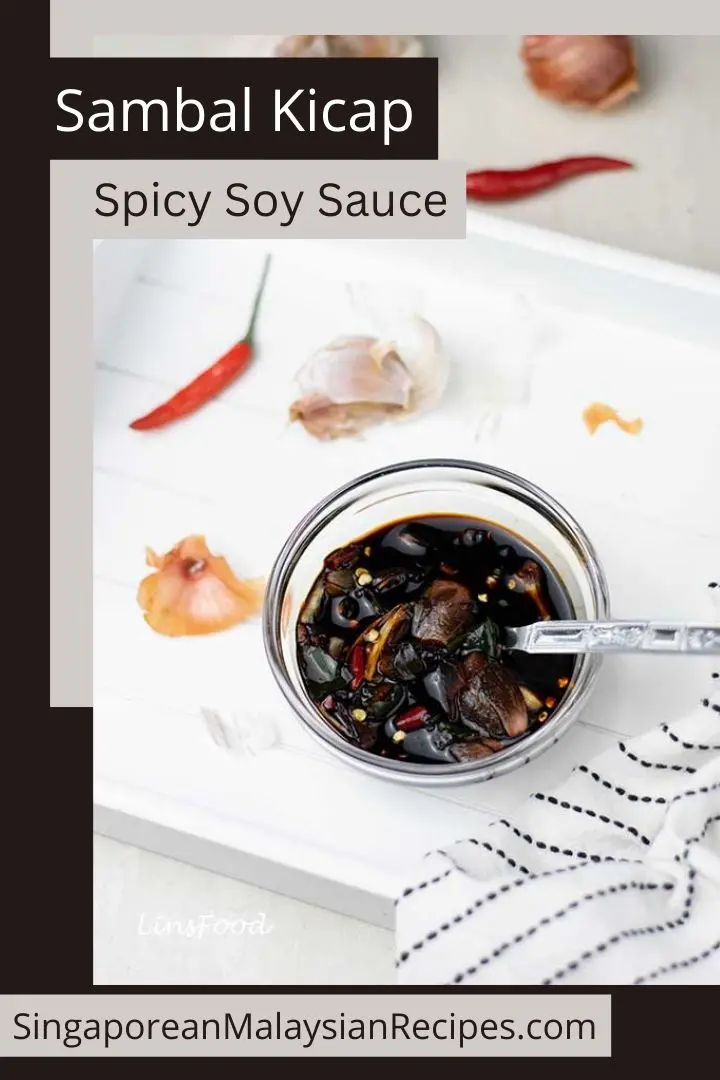
How to Cook White Rice
A question I get asked a lot. I’ll do a whole article on this soon, but let’s do this question quickly.
Cooking white rice on the stove is a simple thing. The only part folks get wrong is the amount of water used, resulting in clumpy or stodgy rice.
If you’re using a rice cooker, just follow the water line suggested in the rice cooker bowl.
If you’re cooking white rice on the stove, here’s a simple rule to follow: just use any cup or small mug to scoop out and measure your rice. Rinse and drain 2x. Then, add 1 more cup of water (same cup) to the rice used.
So if you’re cooking 3 cups of rice, add 4 cups of water. This is the general rule. As you get to know your rice, you may want to reduce the water ever so slightly, if your rice was a little stodgy. Or increase it, if it was too dry. Because every rice is different.
But start off with the 1 cup more of water.
The exception is if you’re only cooking 1 cup of rice. Then you need 1½ cups of water.
This applies to most rice recipes, including our Hainanese chicken rice.
To cook white rice on the stove:
- Let’s cook 4 cups of rice. Rinse and drain 2x.
- Add 5 cups of water. Plus 1/2 tsp salt if you want. I don’t add salt to rice, a habit because of the kids.
- Cook on high until the water evaporates, and you see steam vents (holes) on the rice surface.
- Cover and reduce heat to the lowest setting and cook for 12 minutes.
- After 12 minutes, take it off the heat and leave to rest for 10 minutes before fluffing.
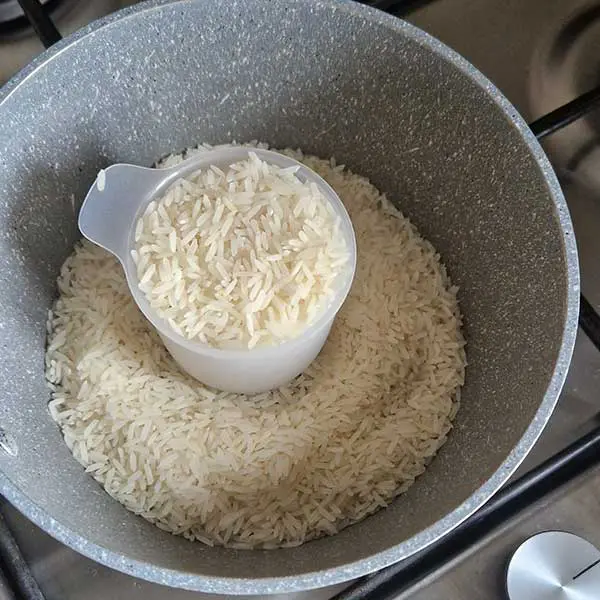
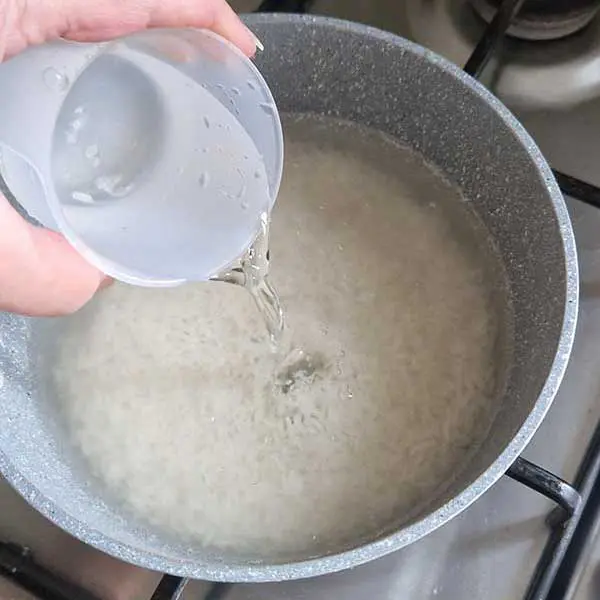

Poultry Hook and Hanging the Chicken
Have I lost you already? I hope not. I promise you, the effort and reading through this article will be totally worth it.
Each time you make the recipe, something will fall into place, allowing you to make the whole process easier and quicker. You know the saying about practice and all that, right?
So once the chicken is done poaching, we need to hang it and rub sesame oil all over it. You need a way to hang the chicken. Let’s take a look.
Poultry Hook for Hainanese Chicken Rice
Poultry hooks are hooks that allow you to hang your poultry up whether to dry as in many East Asian recipes, or to smoke in a smoker. The image below shows you how they work, it’s an old image from a food stall in Malaysia.

For years, I had a tough old time getting my hands on these for cooking Hainanese chicken rice. So I grappled with a metal coat hanger, twisting it this way and that until I was able to hang the chicken with it.
Then I discovered the turkey holder or vertical chicken holder, so graduated to that. In fact, it’s still my preferred way of hanging the chicken to dry as I don’t have to fight the wings and accidentally tear the chicken skin. Like this one on Amazon.
In the video, you see me using 2 cheap and cheerful individual hooks; these are what I tend to use in class, as my students go home with theirs. Affiliate link on Amazon.
This butcher hook is also a good option. Its description says “coat hanger”, amongst other things. I’m a genius, I tell you!
Hanging the Chicken
The turkey/chicken holder I mention above is really the perfect solution, as you don’t have to worry about anything else.
But if you’re using poultry hooks, then you need to hang your chicken somewhere. The kitchen sink is the perfect place for it, as you can see in the image below. Placing a cloth stops the hooks from slipping off.
Can’t use the sink? Keep reading.
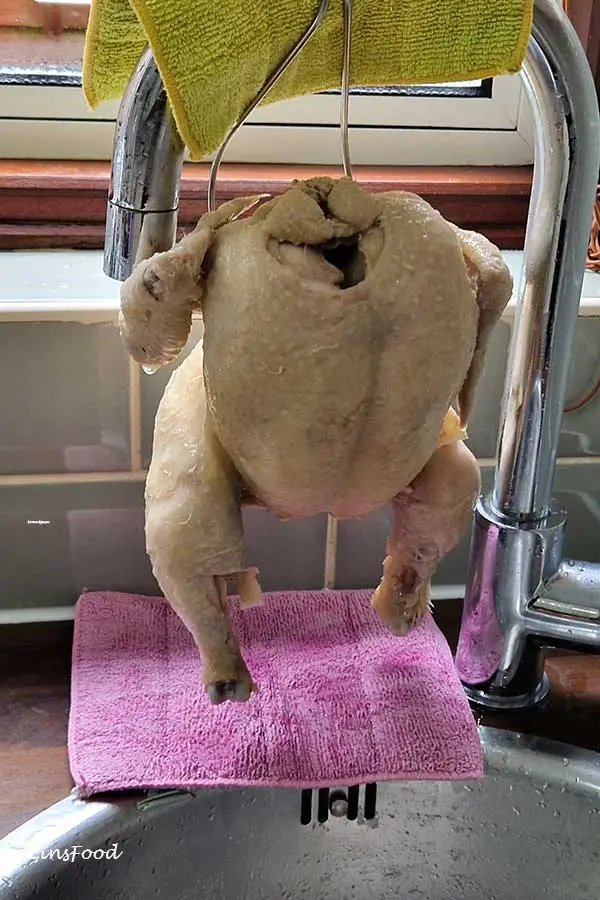
- Get a sturdy long stick about 1 metre/yard long.
- Place it between 2 chairs.
- Place a baking tin in the middle, between the chairs, on the floor.
- Hang your chicken (on the hook) on the stick, leaving it to drip over the tray.
Perfect solution. I used to do this when I lived in a studio flat in London and the sink wasn’t big enough. That was in the 90s!
If you really, really don’t want to go to all this trouble, place your whole chicken, breast side up on a metal rack over a baking tray. This will at the very least, allow the top of the chicken to dry off.
If this is the case, then I suggest you go with chicken portions, whether legs, breasts or thighs.
Food Processor or Mortar and Pestle?
You know me and my food processors, I love them and prefer to use them, especially when making any chilli related recipes.
But the Hainanese chicken rice is one of those recipes that I like to use the mortar and pestle in. But I’m also using a small food chopper as you’ll see in the video (coming in a few days).
I have many, many mortars and pestles and am not afraid of washing up! So in this recipe, I’m using a food chopper and 2 mortars with their pestles.
But you don’t have to do that. Just use one (either), rinse and repeat.
It took me only about 2 minutes to pound the chilli sauce, not counting the mad dash to the tap to rinse my left eye out! See why I like to use food choppers most of the time? I need one of those chemistry set goggles, don’t I?

How to Serve Hainanese Chicken Rice?
Just as you see in the images here.
You serve the chicken sliced or chopped up, with a portion of rice and some sliced cucumber and perhaps tomatoes.
Then you season your chicken soup and place it in a small bowl on the side with the condiments served in tiny little dip bowls.
That’s it.
I know this is a fairly involved recipe. But if you desperately need to eat Hainanese chicken rice and can’t get it anywhere, needs must! So totally worth it!
Phew! Shall we get cooking?
If you enjoy the recipe, drop me a comment and let me know. And if you are feeling like a star, don’t forget that 5-star rating! 😉Thank you!
If you make this recipe, post it on Instagram or Facebook and tag me @azlinbloor and hashtag it #linsfood.
Lin xx
More Hawker Food
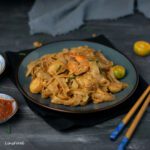
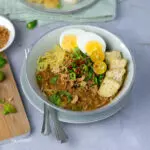

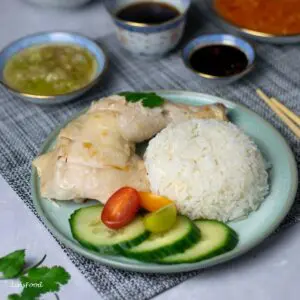
Hainanese Chicken Rice Recipe
Equipment
- 1 large pot for poaching
- 1 pot or rice cooker
- 1 poultry hook or turkey holder
- 1 pestle and mortar or food chopper
- 1 small saucepan
- bowls as required
Ingredients
For the Chicken (Whole Chicken)
- 1 chicken weighing about 1.5kg/3.3 lb
- 1 handful salt if you need to rub your chicken see article
- 6 chicken wings or 2 handfuls chicken bones
- 4 litres water
- 2 tsp salt
- 10 cm ginger
- 3 medium cloves garlic
- 2 stalks spring onions (plus the green bits from the ginger-spring onion oil) (scallions)
- 1 star anise
- 10 black peppercorns
- 2 Tbsp toasted sesame oil
If Using Chicken Portions
- 4 chicken legs or large chicken breasts on the bone or chicken thighs on the bone
- 2.5 litres water
- 1½ tsp salt
- 7.5 cm ginger
- 2 medium cloves garlic
- 2 stalks spring onion (plus the green bits from the ginger-spring onion oil)
- 1 star anise
- 5 black peppercorns
- 2 Tbsp toasted sesame oil
Chicken Rice
- 500 g jasmine rice or any long grain
- 4 Tbsp vegetable oil canola oil, corn oil, etc
- 2 small shallots
- 7 medium cloves garlic
- 10 cm ginger
- 2 pandan leaves optional
- poaching liquid/chicken stock from cooking the chicken amount depends on whether you're cooking in a rice cooker or on the stove
Ginger-Garlic Chilli Sauce
- 6 red birds eye chillies or milder variety, same amount
- 5 cm ginger
- 4 large cloves garlic
- 1-2 tsp white sugar
- ½ tsp salt
- 125 ml poaching liquid
- 1 Tbsp rendered chicken fat
- 1 tsp rice vinegar
Ginger-Spring Onion Oil
- 5 cm ginger
- 3 stalks spring onions (white part only) scallions, aka green onion, green parts go in the stock
- 4 Tbsp vegetable oil
- ⅛ tsp salt
Soy Sauce Dressing
- 3 Tbsp light soy sauce
- 1 Tbsp toasted sesame oil
- 4 Tbsp chicken stock (the poaching liquid)
Chicken Rice Soup (the poaching liquid)
- additional salt
- ground white pepper
- fresh coriander leaves cilantro
To Serve
- 1 small cucumber (more or less, up to you)
- 20 cherry tomatoes (or 3-4 regular)
Instructions
Poaching Whole Chicken
- Bring the chicken out of the fridge at least 1 hour before starting, so it can come to room temperature.Fill a large pot (stock pots or spaghetti pots are great) with the water and bring to a boil. Add the salt, star anise and black peppercorns.
- If you want, you could rub some salt all over the chicken skin to smooth it out. This will remove any tiny bit of feather that may be left behind. I don't usually bother as I don't need to.
- Cut the parson's nose off the chicken (the triangular bit near its end) and discard. It can make your stock a little bitter.Remove the fat deposits from the chicken cavity near its tail and place in your smallest saucepan.

- Scrub the ginger well under running water and place in your food chopper or mortar. Peel and add the garlic. Chop it to a fairly coarse stage and tip into the water.Roughly chop up the spring onions and drop into the water, along with the green ends from the ginger-spring onion oil. Bring the water to a boil.
- If you have poultry hooks, hook 1 under each wing, then lower the chicken into the hot water and immediately reduce the heat to low. Allow the chicken to poach in this gently simmering water for 40 minutes.Ideally, you want the pot to be deep enough so that your chicken floats in the water. Or use poultry hooks to hang the chicken off the side. But don't worry too much about this, just ensure the chicken is breast side up, so we maintain the integrity of the chicken skin on this end.

Poaching and Drying Chicken Portions – Easier Method
- Bring the portions out of the fridge 1 hour before you start cooking, to come to room temperature.Fill a large pot (stock pots or spaghetti pots are great) with the water and bring to a boil. Add the salt, star anise and black peppercorns.
- Turn your chicken portions over and pull out any fat deposits you see under the skin, without tearing the skin. This will be minimal if you're using chicken breast. You'll have the most fat deposits with chicken thighs.Place in a small saucepan.

- Scrub the ginger well under running water and place in your food chopper or mortar. Peel and add the garlic. Chop it to a fairly coarse stage and tip into the water.Roughly chop up the spring onions and drop into the water, along with the green ends from the ginger-spring onion oil. Bring the water to a boil.
- Gently drop the chicken portions into the simmering water and reduce the heat to low and poach for just 20 minutes for chicken legs, 15 for thighs, and 10 for chicken breasts.This is why it's important that your portions are at room temperature.

- Fill a large bowl, saucepan or your sink with water and drop in all the ice cubes.When the time is up, gently scoop out the chicken portions and drop them into the ice bath.
- After 10 minutes, lift them out and place them on a wire rack over a baking tray to catch the drips. Skin side up.Rub the sesame oil all over and leave to dry until you're ready to serve.

Render the Chicken Fat
- Chop up your fat deposits into little pieces and place them in the smallest saucepan you have with 4 Tbsp of vegetable oil or any neutral oil (flavourless). This oil is listed under Chicken Rice in the ingredients above.Because the fat we have won't be enough for our needs, the oil is there to add volume, giving us flavoured fat.You'll probably need even more oil if using chicken portions.

- Render this fat over low heat for 45 minutes, stirring from time to time, until you have crispy bits which means all the oil has been leached out of the fatty deposits.Strain, keeping the oil for later. The crispy bits can be used as a topping for noodles if you like, or, I actually sprinkle them over our finished chopped chicken when I'm serving it.
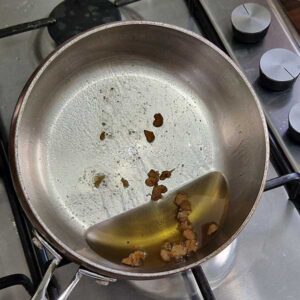
Ice Bath, Season and Dry the Chicken (Whole Chicken)
- Fill a super large bowl, saucepan or your sink with water and drop in all the ice cubes.Gently lift the chicken out of the simmering water and lower into the ice bath. This part can be tricky, even with poultry hooks. One of the best way to do this is to run a thick ladle right through the chicken's cavity and lift it out.
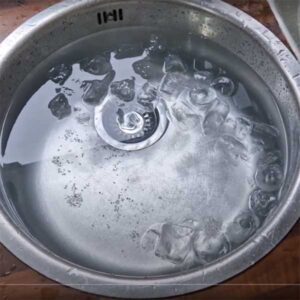
- When the chicken is has had 10 minutes in the ice bath, lift it out using the poultry hooks and hang it off something like your kitchen tap, see video/image.Or use a turkey holder.Read the article above for my diy poultry hook and hanging "station".Leave your poaching liquid simmering away on medium-low while you're doing this.

- Rub the sesame oil all over the chicken and leave it hanging until you're ready to chop and serve.

Flavoured Oil for the Rice
- Peel the shallots, garlic and ginger. Chop or pound 5 cm (2") ginger and 3 cloves garlic to a fine mix. Take it out and set aside for the rice.
- Place the rest of the ginger (5cm/2"), garlic (4 cloves) and shallots in the food chopper or mortar. Chop or pound to get a coarse mix.
- Remember the chicken fat rendering away? Even if it's not quite done, get most of the oil out and pour it into a small frying pan. Leave behind about 1 Tbsp for our ginger-onion oil.You want about 6 tablespoons of oil. So top it up with more oil if there isn't enough rendered oil. If your chicken fat pieces are not quite crispy, leave them on for a few more minutes but keep and eye on them.
- Heat this oil over medium heat and fry the chopped aromatics for about 2-3 minutes until they are a golden colour.Strain this flavoured oil into a small bowl using a metal strainer. Discard the solids.

Chicken Rice on the Stove Top
- Rinse the rice and drain well. Place in your saucepan if not already in there. Remember the minced garlic and ginger from earlier? Step 1 above. Tip that onto the rice.
- Add 750ml of the poaching liquid (3 cups), the flavoured oil and salt. If using pandan leaves, tie them up into a knot and add to the rice.Give everything a stir and cook on high until all the liquid has evaporated and you can see steam vents (holes) on the rice surface. This can take anything from 10 – 15 minutes, depending on the initial temperature of your water. You know, summer, winter, tropics?Reduce the heat for the poaching liquid to low at this point.

- Briefly stir the rice and push the pandan leaves to the bottom.Cover with a lid and cook for 12 minutes. Then take it off the heat and leave to rest for 10 minutes before fluffing and stirring.

Chicken Rice in Rice Cooker
- Rinse the rice and drain well. Place in your rice cooker. Remember the minced garlic and ginger from earlier? Step 1 in Flavoured Oil. Tip that onto the rice.Over the years, I've learnt not to rinse my rice in the rice cooker, as there may be particles that can scratch it. You don't want to scratch your rice cooker, especially if it cost a pretty penny like mine, Yum Asia Bamboo Rice Cooker.
- 500g of rice would be 4⅓ rice cooker cups. So that's exactly how much chicken stock you're going to need to cook your chicken rice in the rice cooker. Unless your rice cooker says differently. Don't think it would but one never knows.So add 4⅓ cups poaching liquid, the flavoured oil and the salt. If using pandan leaves, tie them up into a knot and add to the rice.Stir with a wooden spoon (or your rice cooker paddle) and turn it on to cook.When done, leave to rest for 5 minutes before fluffing.Reduce the heat for the poaching liquid to low at this point.
Ginger-Garlic Chilli Sauce
- I do this with a mortar and pestle, but use a food chopper if you prefer. Place the chillies, ginger, garlic, 1 teaspoon sugar and salt in your mortar or chopper. Pound or chop until you have a fairly fine mix.

- Add the poaching liquid, rendered fat and rice vinegar and stir well.Taste the chilli sauce. Add more sugar if you want or salt. It should be a pretty gingery and sweet mix. Not too hot.Now pour out into a bowl, ready to be served.

Ginger-Spring Onion Oil
- Peel the ginger and chop up roughly, then place in the mortar or food chopper. Rinse your pestle and mortar/chopper if using the same one.Chop up the bottom lighter part of the spring onions roughly and add to the ginger, along with the salt.Pound to a semi coarse mix.

- Heat the oil in a small frying pan over medium heat until the oil is shimmering and hot.Take it off the heat and immediately tip in the ground ginger mix in and stir well. Pour this delicious oil mixture into a small dip bowl and set aside.

Soy Sauce Dressing
- Mix all the ingredients in a bowl and set aside.
Sambal Kicap
Chicken Rice Soup
- By this time, when you've made everything else, your poaching liquid would have been simmering away for 30 – 45 minutes. Or longer. So it should have reduced and be fairly flavoursome.This is crucial. The soup accompanies your chicken rice and adds more flavour to the fairly plain but aromatic rice.
- Strain your soup into a fresh saucepan (I know, so much washing up).Taste the soup and add more salt if required, along with a dash or two of white pepper.
To Serve Hainanese Chicken Rice
- If using a whole chicken, chop up the chicken into serving portions and lay out on a platter.I take the legs off, then split the chicken into two. Then, I pull the bone off to release the 2 chicken breasts.Then everything gets chopped up with a cleaver or a large super sharp knife. Watch your fingers.

- Drizzle about 2 Tbsp of the dressing all over the chicken pieces.
- Slice the cucumbers and halve the tomatoes and arrange on a side plate, or all around the chicken. Drop a few coriander leaves (cilantro) over the chicken to look like a pro.
- Dish up a portion of rice for each person on a plate, using a small bowl for the rounded look, if you like.
- Place your chopped chicken, rice and vegetables on the dinner table.
- Now bring the soup to the table and pour into individual bowls and top with a coriander leaf.
- Bring all the dipping sauces and the rest of the dressing to the table. Everyone helps themselves to the sauces with their own soup bowls next to them.

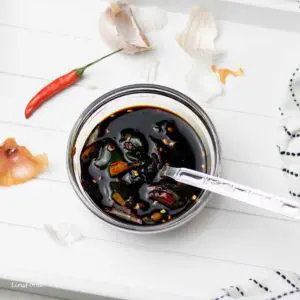
6 thoughts on “Authentic Hainanese Chicken Rice Recipe”